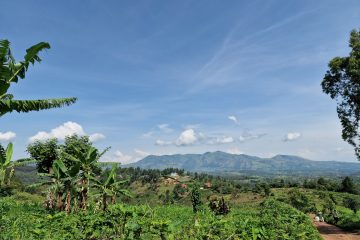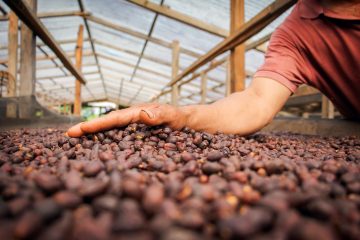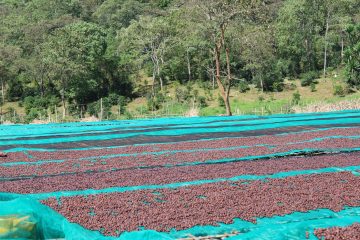
Compared to the neighboring country Kenya you have to digg deep to find the super complex and intense fruit driven coffees in Tanzania. Still, there is great potential around. Price wice it’s cheaper coffees in general than in Kenya and Ethiopia . If you are looking for heavy bodied and sweet coffees with flavors of dark cherry, cocoa and roasted nuts Tanzania might be something to look in to. There are other flavor profiles towards more floral, rosehip, rubbarb and citrus, but they can be hard to find. So far I find those coffees mostly to be from Kigoma or the south. Some of the more solid coffees can be found from the Estates around the Ngorongoro crater at higher altitudes.

General information
Tanzania lies between longitudes 30 – 40 degrees and latitudes 1-12 degrees. It covers an area of 945.087 square kilometers and the distances between the different coffee regions are huge. The most interesting coffee areas in the north and south has an altitude ranging from 1500 – 1800 meters. There is about 500.000 coffeefarmers, and about 2 million people involved in the coffee industry. 90% of the producers are small holders with between 0,5 – 3 hectare of land. Less than 10% of the coffees are grown at larger Estates.
Main Areas Northern: Kilimanjaro Area (Moshi), Mount Meru (Arusha) Karatu (Ngorongoro) Kigoma (representing 20% of total production) Bukoba and Tarime far north is producing mostly Robusta and represents 40 % of total production.Main areas southern: Mbaya/Mbozi (20% of total production), Mbinga (20% of total production)
In general the numbers of smallholders in the north around Mt. Kilimanjaro seems to decrease, even if there are some projects developing and supporting CPU’s and coops. There is a positive development in some areas in the south, and high hopes for quality. Most of the Estates are in the North around Moshi/Arusha and up in Ngorongoro.

Varieties and plants
Coffee was brought in to Tanzania by the French Missionaries in the 1890’s and planted in the Kilimanjaro Area. This is the Bourbon varieties that was introduced to Kenya later on. The Kent varieties coming from Mysore in India was introduced and planted in the 1920’s, and there is a variety called Nyasa Strain, Menado, Rumi Sudan you have some Catimors and others. In general there are two traditional varieties that are videly used, the Bourbon related hybrid N 39 and the Kent variety, KP 432, as well as traditional Kent varieties K7 and K9. TACRI (Tanzanian Coffee research Institute) has developed hybrid varieties from the old traditional Bourbon trees to be more disease resistant, specially to CBD. In stead of distributing seedlings to farmers they have several nurseries where they plant cutlings from several trees. They believe planting cutlings, in opposite to have seeds will even out the odds of having one block full of trees with the sme set of bad genes. They also distribute catimors and other high yield Arabica/Robusta hybrids. For more info http://www.tacri.org

Growing conditions and production
In general the production of the smallholders are extremely low, about one kg of cherry pr tree, and the potential could easily be 5 with the right treatment. Many of the trees are extremely old, and not always able to give a great yield, but in general a lot could be done with right pruning, mulching and inputs. In general the soils in the north is volcanic and full of minerals, and the soils of the south are rich and fertile. An average production of green coffee from a smallholder would typically be 200 kg of greens pr hectare, the production at estates would be about 1000 kg’s of green coffee pr hectare. The Estates are also struggling these days in general because of droughts and lack of water. Most growers in the north are dependent on irrigation to get a good yield as well as enough water for processing. Many of the Estates have bore holes or they are constructing water dams and reservoirs to ensure enough water for irrigation and during harvest. Depending on the rains and flowering.

Cherry reception
The main harvest will for most areas start in June, but can be earlier, peak around August/September (depending on altitude and weather) and end in October. Some producers have pretty strict routines for cherry picking and reception, but in general the acceptance of half ripes is high. You can find CPU’s where they use buckets to skim of the floaters at cherry reception. The better producers makes sure the coffees are sorted by the pickers/farmers in the fields or at deliverance.

Processing, washing and drying
There is no standard way of processing coffees in Tanzania. In general the coffee is pulped by a traditional disc pulpers like Mckinnon and dry fermented before washed. Some Estates and CPU’s have aquapulpers like pentagos and use a mucilage remover. Some coffees are soaked in clean water after fermantation or mucilage removal and some are not. This can even vary from batch to batch from one single producer depending on water access and capacity. They traditionally ferment for 30-40 hours. In some cases this seems to be longer then necessary and done by tradition. But it really depends on the temperature at present time. Still there are some producers that have awareness and are improving their processes by doing trials and experiments.
As many of the producers this days have water capacity issues they are looking at ways to save water during processing. Some convert to demucilagers and some recycles water back in to the process. If done well under strict controle recycling is ok, but it can also be risky if they process with polluted water.
After washing or soaking the parchment it’s spread out on raised tables, drained and at most of the serious producers hand sorted for defected parchment. They do have occasional rains during the drying period, and challenges on drying. It can also be to hot in the middle of the day. If they are not careful covering up the parchment it will crack up, and affect the degrading/aging and cup profile. The drying time seems to vary from 5-14 days depending on the weather, occasional rains and micro climate. There is hardly any use of moisture meters anywhere, and the general qualities seemed to be unstable with everything from 9,5 to 13% moist.

Parchment and storage
After drying the parchment is stored in local warehouses until they have enough to send to the mill. Normally they will mix the daily lots randomly when finished at the drying tables. The coffee would normally be milled emediately and stored in green beans. When coffee is sold at he auction it’s often moved to warehouses in Dar es Salaam. In general storage conditions both in Moshi and especially Dar es Salaam can be challenging.

Grades and qualitites
Cupping through several parchment lots from the same producers shows pretty big differences in quality. Accordingly to the blocks or farms where the cherries comes from, how the conditions are during process and drying, ripeness of cherries and of course awereness during chain of all operations, the quality will vary. It seems like focusing on the peak of the season will as in most cases normally give a more consistent profile.
The standard grades based on size is more or less the same as in Kenya. In terms of “quality” you have AA (18 up), AB (15, 16,17) and PB. Then you have C grade, E (misfostered Elephant beans) AF, TT, T and F’s. This are lighter beans from the grades mentioned above.
Fully washed
On top of the quality chain you have the Estates or CPU processed coffees considered as “fully washed”. They can be great but even here you will often find inconsistency and defects. Specially over fermentation.
Then you have the organized coops where the coffee are processed by smallholders, but some of them have a certain extent of quality control at farm level and the coffees can occasionally be clean and transparent.
You have local parchment buyers. Most of them will buy and blend random smallholder coffees of various and poor quality from certain areas, mix it and sell it to the mills. In general poor cup quality. Many of the mills work in close relationship with, or have their own parchment buyers to ensure volumes.

The trade
The way coffee is traded in Tanzania makes it challenging, but not impossible, to source quality. You are allowed to do direct export (DE) but the specific sale, contract and quality has to be approved by the Tanzanian Coffee board. The main focus for the exporters is volumes of average commercial quality. Most of the coffee goes through the TCB (Tanzanian Coffee Board) auction, and it is almost as defected coffee is excepted. The quality controle of coffees going through auction is monitored by the lab of TCB. Still, if you look at the coffees, even the supposedly clean AA’s A’s and B’s rated as quality there will often be black beans, over fermented and in general a high level of defects. Strangely enough they still get good premiums this days and this does not give good incentives for the farmers and millers to increase quality in general. To do direct export you have to get the approval based on sample by the TCB. This is a confusing and often a time consuming process and will delay sales and exports. Very often farmers that have direct relations with importers and roasters even take the coffees through auction, buy it back and ship it direct to avoid the hassle with the direct export license.

Dry mills and Exporters
Most producers work in close partnership with drymills. As soon as they have a descent amount of parchment, sometimes almost straight from the drying tables, it’s trucked to the mill. Very often they mill it immediately to present it in the auction catalogue. Occasionally the coffee is conditioned or stored in parchment in a warehouse, but in general there are few following strict routines as such.The exporters are not allowed to have their own mills and this requires a different license. Still most exporters divide milling and exports in to two separate companies managed as one, to get around the law. Tanzanian coffees are known to fade quickly and I think the reason is a mix of factors. Over/underdrying is an issue, no conditioning and storage in higher altitudes, coffees are often polished in the dry mills to look better, and get heated during this process. On top of that the coffee is often stuck in Dar es Salaam with high humidity and temperature. I believe if you work with producers and exporters to controle this factors it should improove dramatically.


